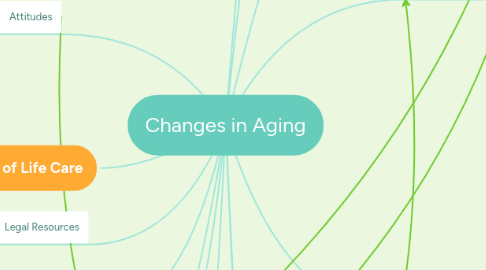
1. Attitudes
1.1. Ageism
1.2. Stamina
1.3. Flexibility
1.4. -
1.5. Parenting
1.6. Grandparenting
2. End of Life Care
2.1. Loss of a spouse
2.2. Hospice
2.3. Palliative Care
2.4. Feelings of being alone
2.5. -
2.6. Retirement
3. Legal Resources
3.1. Lawyers
3.2. Will planning
3.3. End of life planning
3.4. Advance directives
3.5. Hospice care planning
3.6. Will writing
4. Economic Resources
4.1. Medicare
4.2. Social security
4.3. Medicaid
4.4. Food delivery programs
4.5. Home health programs
5. Critical Resources
5.1. Nursing homes
5.2. Rehabilitation centers
5.3. Hospitals
5.4. Independent living locations
6. -
7. Comorbidities/Disease Process
7.1. Diabetes
7.2. Arthritis
7.3. Hypertension
7.4. Cancer
7.5. CHF
7.6. Malnutrition
7.7. Skin integrity
7.8. Respiratory Infections
7.8.1. Pneumonia
7.8.2. Tuberculosis
7.8.3. Respiratory failure
7.9. Depression/Anxiety of aging
8. Social Clubs
9. Ethical Resources
9.1. Church groups
9.2. Worship services
9.3. Priests/pastors at home parish
9.4. -
10. Social Resources
10.1. Group Homes
10.2. Senior Citizen Sports Leagues
10.3. -
11. -
12. Age-Related Changes
12.1. Reproductive Changes
12.1.1. Loss of menstrual cycle
12.1.2. Decrease in hormones/sex drive
12.1.3. Stigma associated with reproduction
12.1.4. -
12.2. Neurological Changes
12.3. -
12.4. Endocrine Changes
12.4.1. Thyroid gland atrophies
12.4.2. Diminished adrenal function
12.4.3. Pituitary volume decreases
12.4.4. Insufficient release of insulin
12.4.5. -
12.4.6. Glucose intolerance
12.4.7. Hypothyroidism
12.4.8. -
12.4.9. -
12.4.10. Hyperthyroidism
12.5. Musculoskeletal Changes
12.5.1. Loss in muscle tone
12.5.2. Loss of strength
12.5.3. Prone to inflammation
12.5.4. Tendons and ligaments become worn down
12.6. Pulmonary Changes
12.6.1. Calcification of costal cartilage
12.6.2. Reduction of cough and laryngeal reflexes
12.6.3. Increased residual capacity
12.6.4. Decreased vital capacity
12.6.5. High risk for respiratory infections
12.7. Cardiovascular Changes
12.7.1. Lower resting heart rates
12.7.2. Lower blood pressures (on average)
12.7.3. Inability to stay warm as well as when younger
12.7.4. -
12.7.5. Decreased skin circulation
12.8. Skeletal Changes
12.8.1. Loss of bone density
12.8.2. Osteoporosis/weakening of bones
12.8.3. Change in stature
12.8.3.1. Shrinking in height
12.8.3.2. Bent over/stooped
12.9. -
12.10. Sensory Changes
12.10.1. Decrease in taste buds/taste sensory
12.10.2. Decrease in vision acuity
12.10.3. Decrease in sense of smell
12.10.4. Decrease in hearing acuity
12.11. Cellular Changes
12.11.1. Functional cell numbers decrease
12.11.2. Lean body mass decreases
12.11.3. Total body fat decreases
12.11.4. Extracellular fluid stays the same
12.11.5. Intracellular fluid decreases
12.12. Physical Appearance
12.12.1. -
12.12.2. Hair loss
12.12.3. Greying hair
12.12.4. Loss of tissue elasticity
12.12.5. Elongated ears
12.12.6. Baggy eyelids
12.12.7. -
12.12.8. Double chin
12.12.9. Lack of appetite
